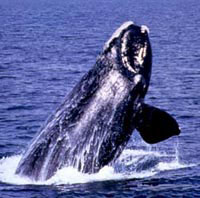Chris Slay wears bib overalls and wire-rimmed glasses, occasionally recites poetry, and watches right whales for a living.

Once more into the breach.
David Wiley, National Marine Fisheries
Service.
After this year’s dismal right whale calving season, the poetry that comes to Slay’s mind is darkly pessimistic. The rarest whale of them all may be getting rarer.
The Northern right whale, the most endangered of the big whales, travels south each winter from Canada’s Bay of Fundy to give birth in its only known calving grounds, the warm, shallow coastal waters off south Georgia and north Florida.
Few whales showed up, though, for the 1999-2000 calving season. And only one birth was confirmed by a photo despite teams of researchers combing the area in planes and small boats for 38 days, logging more than 26,000 miles. A second calf was spotted, but not confirmed.
Researchers like Slay, of the New England Aquarium, are worried. He doesn’t want to say he’s seeing the last Northern right whales, but extinction is a strong possibility unless more babies are born.
“I don’t think any of us working with these animals are ready to throw in the towel,” he remarked. “Many of us don’t want to readily admit that these whales might be on the ropes, but there’s definitely blood on the mat.”

Map: Office of Naval
Research.
Scientists estimate that only 300 to 350 of the Northern right whales are left — so few that researchers know the females by sight and by name. The number of calves born has been falling steadily. Twenty-one births were recorded in 1996, 18 in 1997, six in 1998, and four in 1999.
Not only babies were missing this year. Fewer adults — less than a half dozen — were seen. During a normal season, 35 or 40 adults and juveniles are spotted.
It’s enough to leave Slay quoting the darker lines from T. S. Eliot (“This is the way the world ends, not with a bang but with a whimper”) and Dylan Thomas (“Rage, rage against the dying of the light”).
Love at First Right
Slay saw his first right whale in February 1988 while he was working as an observer on a dredge that was digging a channel for the Navy’s submarine base in Kingsland, Ga. — right in the middle of an area now identified as right whale critical habitat.
“She was number 1704 and I’ll never forget her,” Slay said.
A few years earlier, Savannah-based naturalist Cathy Sakas found a dead right whale calf — umbilical cord attached — on a remote Georgia island. It was the first proof anyone had that right whales were present and giving birth in Georgia waters. Until then, all right whale research was done in the Bay of Fundy, where the whales appear each summer.

Having a whale of a time.
Chris Slay, New England Aquarium.
After his encounter with 1704, Slay wrangled a part-time job with the New England Aquarium’s summer whale program in Fundy. He’s been watching whales professionally ever since — traveling to the calving grounds in the winter and to Fundy in the summer.
This is the most dismal year he’s had.
But there are a few bright spots. For one, the port of St. John, New Brunswick, on the Bay of Fundy is considering shifting local shipping lanes to get ships out of the way of whales. “It’s a big deal to be discussing that sort of change,” Slay said.
Historically, collisions with ships have been the leading cause of death for adult right whales. In the Southeast, Slay and others run an early warning system that alerts ships by radio when a whale is in the area. There have been no ship strikes of right whales in the Southeast in several years.
The fishing industry presents another obstacle for the whales, though. Two to four adults get entangled in fixed fishing gear each year in the Northeast. Sometimes whale watch teams are able to get close enough to cut the gear away. Usually, though, entanglement results in death.
“[The gear] is all very heavy; it does not rot,” Slay said. “So it cuts deeper and deeper. It’s a slow, agonizing, horrible death.”
With a population so low, the loss of even one individual — whether from ship strike or entanglement — is a body blow to the population.
Krilling Me Softly
This year, when whale watchers expanded their search into waters off the Carolinas, north of the calving grounds, they found whales farther off shore than normal. It’s possible that the whales have been kept from their usual territory by three years of abnormal weather — caused by the swing between El Niño and La Niña — and unusually warm coastal waters.

There she blows … for now.
National Marine Fisheries Service.
Some scientists theorize that weather anomalies, which can stir deep sea currents, hamper the whales’ search for food. The huge mammals, which have no teeth, feed by straining tiny tidbits — krill and microscopic shrimp — through modified hairs in their mouths called baleen.
The females might not be finding enough food to support a successful pregnancy. And pregnancy intervals — the years between giving birth — may be lengthening.
This is bad news for a struggling population. Whales take a long time to reach sexual maturity and only a healthy birthrate will guarantee the species’ survival.
Researchers will hold their breaths until summer, when the whales make their annual appearance in the Bay of Fundy. Perhaps a few mothers and calves will show up.
A last bit of hopeful news: A lot of known young females in the remaining population are coming into their reproductive years and some older females are due for a calf. If global weather patterns normalize, researchers hope they could be tracking as many as 20 calves next year.

